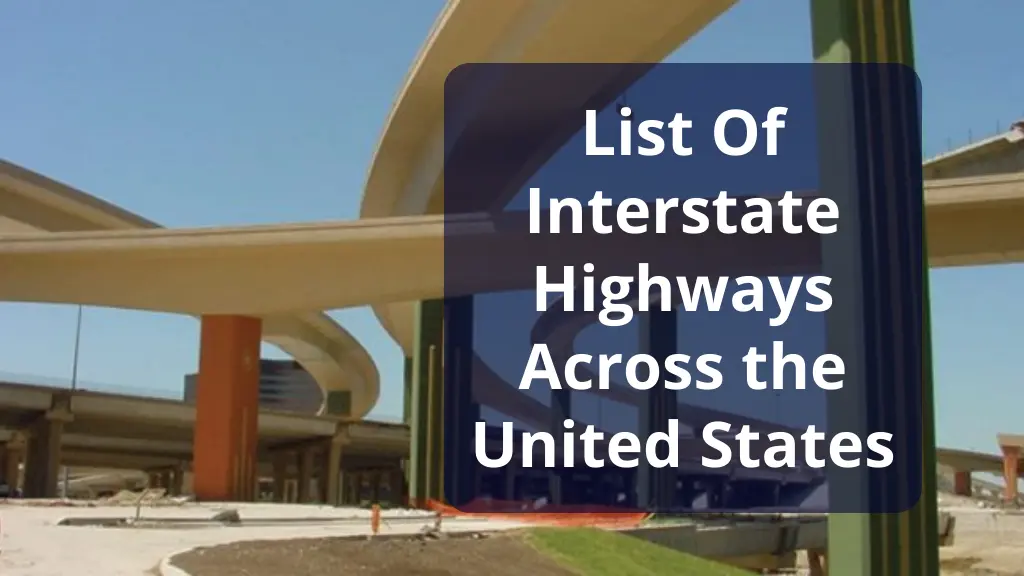The List of Interstate Highways is far more than a simple outline of roads; it represents the backbone of America’s modern transportation system and one of the greatest infrastructure achievements in history. Spanning thousands of miles and stretching across nearly every state except Alaska and Hawaii, the network unites cities, towns, and rural communities, ensuring the seamless movement of people, goods, and essential services. Developed during the 1950s under the vision of national connectivity and defense preparedness, the interstate system quickly became central to economic growth, tourism, and military strategy. Over the decades, it has evolved into a lifeline for long-distance travelers, commercial trucking, and regional development. Understanding each highway individually helps highlight how this vast system functions not as isolated routes but as an interconnected web that powers commerce, strengthens communities, and maintains the flow of daily life across the entire United States.
List of Interstate Highways
The Interstate Highway System was developed under President Dwight D. Eisenhower in 1956 with the Federal-Aid Highway Act. The goal was to create a connected system of controlled-access highways that would improve safety, efficiency, and defense mobility. Over the years, the system expanded to cover more than 48,000 miles, making it the largest highway network in the world. Each road is numbered systematically, with even numbers running east–west and odd numbers running north–south.
East West Interstate Highways
I-10
Interstate 10 is one of the most significant east–west highways, stretching from Santa Monica, California, to Jacksonville, Florida. Passing through major cities such as Los Angeles, Phoenix, Houston, and New Orleans, it provides a direct route across the southern United States. It is a critical corridor for trade with Mexico and serves as a major route for both freight and travelers seeking to move between the Pacific and Atlantic coasts.
I-40
Interstate 40 runs from Barstow, California, to Wilmington, North Carolina, and covers more than 2,500 miles. It is a popular route for cross-country travel, connecting cities like Albuquerque, Oklahoma City, Little Rock, and Nashville. Known for its scenic stretches, including portions that parallel the historic Route 66, I-40 is essential for connecting the Southwest with the Southeast.
I-70
Interstate 70 is a central east–west route that extends from Cove Fort, Utah, to Baltimore, Maryland. The highway crosses the Rocky Mountains, providing some of the most breathtaking views along the interstate system. It passes through Denver, St. Louis, Columbus, and other major cities, making it a key connection between the Midwest and the East Coast. Its mountainous sections challenge travelers but also attract tourists.
I-80
Interstate 80 is one of the longest highways in the system, stretching from San Francisco, California, to Teaneck, New Jersey. It traverses the heart of the country, linking Chicago, Omaha, Des Moines, and Salt Lake City. Known for supporting long-haul trucking, it serves as a vital artery for goods transported across the country. The road is also popular for road trips, offering diverse landscapes from the Sierra Nevada to the Great Plains.
I-90
As the longest interstate in the United States, Interstate 90 runs nearly 3,100 miles from Seattle, Washington, to Boston, Massachusetts. It connects northern states and passes through cities like Spokane, Chicago, Cleveland, and Buffalo. The highway plays a vital role in linking the Pacific Northwest to the Northeast. Its stretches near the Great Lakes make it both a scenic and strategically important route.
North South Interstate Highways
I-5
Interstate 5 runs along the entire West Coast from the Canadian border in Washington to the Mexican border in California. It connects major metropolitan areas including Seattle, Portland, Sacramento, Los Angeles, and San Diego. This route is essential for international trade, tourism, and regional travel, as it is the only continuous north–south interstate along the Pacific Coast.
I-15
Interstate 15 stretches from San Diego, California, to the Canadian border in Montana. It passes through cities such as Las Vegas, Salt Lake City, and Great Falls. The highway serves as a gateway to many national parks, including Zion and Yellowstone. It is an important corridor for both domestic travelers and international visitors heading to tourist destinations in the West.
I-35
Interstate 35 runs from Laredo, Texas, on the Mexican border to Duluth, Minnesota. It splits into I-35E and I-35W through both Dallas–Fort Worth and Minneapolis–Saint Paul, reflecting the importance of serving twin metropolitan areas. Passing through cities like San Antonio, Austin, and Kansas City, it is one of the most vital trade routes between Mexico and the Midwest.
I-55
Interstate 55 begins in New Orleans, Louisiana, and runs north to Chicago, Illinois. It connects the Gulf of Mexico with the Midwest, passing through Memphis and St. Louis along the way. The highway has historical significance as it follows much of the old Route 66 path. It serves as an essential freight and passenger corridor linking southern ports to northern industrial hubs.
I-75
Interstate 75 runs from Miami, Florida, to Sault Ste. Marie, Michigan, at the Canadian border. It connects key cities such as Tampa, Atlanta, Cincinnati, and Detroit. The highway is one of the busiest north–south routes, providing access to manufacturing centers in the Midwest and tourist destinations in Florida. It is also a critical path for seasonal travelers moving between the northern and southern states.
I-95
Interstate 95 is the main north–south highway on the East Coast, stretching from Miami, Florida, to Houlton, Maine, at the Canadian border. It passes through nearly every major East Coast city, including Washington D.C., Baltimore, Philadelphia, New York, and Boston. It is one of the busiest highways in the country, heavily used by commuters, tourists, and commercial transport.
Regional and Connector Highways
I-20
Interstate 20 runs from West Texas to South Carolina, linking cities such as Dallas, Atlanta, and Columbia. It serves as an important east–west connector in the southern United States, balancing regional traffic away from I-10 and I-40.
I-30
Interstate 30 runs through Texas and Arkansas, linking Dallas to Little Rock. Though shorter in length compared to others, it is significant for local trade and regional connectivity within the South.
I-64
Interstate 64 stretches from Missouri to Virginia, connecting St. Louis, Louisville, and Richmond. It plays a vital role in linking the Midwest to the Mid-Atlantic and supports regional industry and commerce.
I-81
Interstate 81 runs from Tennessee to New York, closely following the Appalachian Mountains. It is a major trucking corridor, connecting southern agricultural regions with northeastern industrial centers.
I-85
Interstate 85 connects Alabama to Virginia, passing through Atlanta, Greenville, and Charlotte. It is crucial for economic growth in the Southeast, supporting industries, tourism, and major urban centers.
Designated Market Areas (DMA)
Designated Market Areas (DMA) are geographic regions that define specific television and advertising markets, but they also overlap significantly with transportation networks. Highways like I-95 and I-10 connect DMA regions such as New York, Los Angeles, Miami, and Dallas. These interstates allow for smoother flow of people and goods within high-demand markets. Smaller DMAs benefit from regional interstates like I-64 and I-81, which strengthen connections between local economies and larger metropolitan hubs.
Importance of the Interstate System
The Interstate Highway System is essential not only for travel but also for the economy. It supports trade, trucking, tourism, and national defense. Businesses depend on efficient highway connections to transport raw materials and finished goods, while travelers rely on these roads for vacations, commuting, and relocation. Beyond economics, the highways also play a role in disaster response, evacuation, and connecting rural areas to urban centers.
FAQs
How are Interstate Highways numbered?
Even-numbered highways run east–west, with lower numbers in the south and higher numbers in the north. Odd-numbered highways run north–south, with lower numbers in the west and higher numbers in the east.
What is the longest Interstate Highway?
The longest is Interstate 90, stretching nearly 3,100 miles from Seattle, Washington, to Boston, Massachusetts.
What is the busiest Interstate Highway?
Interstate 95 is considered the busiest, as it connects nearly every major East Coast city and supports heavy commuter and freight traffic.
How many miles does the Interstate System cover?
The system covers more than 48,000 miles, making it the largest highway network in the world.
Why are Interstates important to the economy?
They are vital for the efficient transportation of goods, services, and people, ensuring that industries, cities, and regions remain connected.
Conclusion
The List of Interstate Highways reflects not only the strength but also the incredible scope of America’s transportation system, serving as the lifeblood of national connectivity. From I-5 running along the Pacific Coast to I-95 stretching across the Atlantic seaboard, and from the southern corridors of I-10 to the northern span of I-90, each route plays a critical role in weaving together the fabric of the nation. These highways ensure that the United States remains mobile, unified, and economically competitive by supporting trade, tourism, defense, and everyday travel. For businesses, they create a reliable framework for transporting raw materials and finished products to markets across the country. For travelers, they open opportunities to explore diverse regions, cultures, and landscapes with efficiency and safety. And for the nation as a whole, they symbolize progress, resilience, and unity. Whether serving commerce, military readiness, or family road trips, the interstate network continues to stand as one of the most transformative infrastructure achievements in U.S. history, a system that will remain vital for generations to come.
Related Post:





